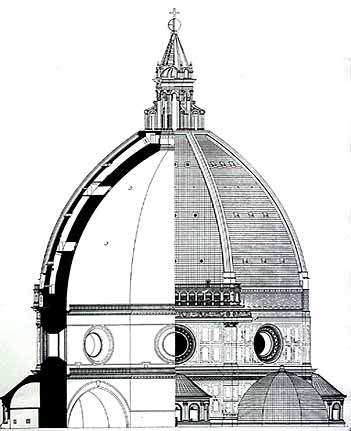
The dome is surprisingly modern: in this double shell, the lighter exterior cupola protects the inner cupola from the elements, while the two work together thanks to the powerful connecting ribs.
The Duomo
Brunelleschi built it using remarkable technical knowledge to achieve the uniquely beautiful results we see today. Completed in 1436, the Cupola is the most characteristic feature of the Florentine skyline
The diameter of the inner span (m. 41.50) is close to the maximum limit for any kind of masonry dome. From the times of the Pantheon there had been no examples of cupolas of such size. Faith in these structures had been seriously undermined by the collapse, in 1346, of the dome of Hagia Sophia in Constantinople. In 1400 the Florentines had had to reinforce the structures of the Baptistery which had shown signs of giving way.
 |
Instead of recuperating precedent techniques, Brunelleschi
invented a technique based on his knowledge of the "way of building"
of the Romans as well as medieval (eastern) examples which he put at the
service of a new concept and new kinds of technical, cultural, aesthetic
problems, involved in the realization of the cupola. Basically the construction
of the dome depended on the use of a building technique capable of avoiding
any dangerous discontinuity in the masonry (27,000 tons) and which would
be able to circumvent the enormous problems involved in constructing a traditional
wooden armature of the necessary dimensions. Brunelleschi's structure of
bricks laid in herringbone courses consisted of raising the wall in rings,
each containing vertical elements for bonding the successive ring. The cupola
was thus built as a self supporting growing form. The dome is surprisingly modern: in this double shell, the lighter exterior cupola protects the inner cupola from the elements, while the two work together thanks to the powerful connecting ribs. |